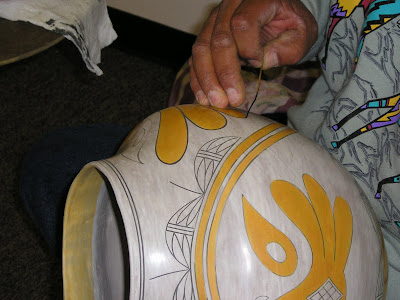Haak’u, The Place Prepared
For nearly two years, I have been bringing you books that influence travel from A Traveler's Library. This year I am going to swerve away just a little bit from that task. For ten years now, I have been researching a book I wrote with Charnell Havens. The book is called Quincy Tahoma: The Life and Legacy of a Navajo Artist. In the process of doing so, I have visited and re-visited many corners of the American Southwest--a cultural treasure chest. Jessie Voigts and I thought that you might be interested in hearing about the American Southwest and the many sites and cultures to see there. I start with Acoma Pueblo, near Albuquerque, New Mexico. And of course, I can't resist slipping in a book reference. Hope you enjoy this journey. Vera Marie Badertscher
Acoma - Enchanted Mesa
Haak’u, The Place Prepared
At Acoma Pueblo, we stand on the edge of a sharp cliff, looking out over the desert land to a neighboring finger of rock called Enchantment Mesa. The surrounding flat desert and the occasional pinnacles of sandstone, rising abruptly toward the turquoise sky, present a weirdly beautiful landscape. We are in “Sky City,” a collection of houses made of mud, perched on top of a 350-foot mesa.
Our guide, Jeri Tsethlikai gazes across the wide space and remembers the story.
“When the people needed to move, they sent out scouts to find a new place to live. The scouts were told, “As you go, shout ‘Haak’u’ and there will be an answer when you find the right place. As they came to Enchantment Mesa and called ‘Haak’u’,” Jerry says, as drawing out the haunting word, “an echo answered, ‘Haak’u’ and they made their new village on that place.”
Haak’u means, “The place prepared.” The Acoma believe that their gods prepared a special place for them to live, perfect in every way.
Visiting Acoma
From the time that the Spanish Conquistadors arrived in 1540, through the arrival of the railroad and Route 66, Acoma people have welcomed visitors to their 1200-year-old home about 45 minutes from Albuquerque.
The visiting Spanish changed the native word for their mesa pueblo from Haak’u to Acoma. Later writers gave the village perched on top of a sheer cliff the nickname “Sky City.”
Today cars turn off I-40 at the Sky City Casino and Hotel and drive fifteen miles to the base of the pueblo's mesa, totally hidden from the highway. There the new Acoma Cultural Center, itself a work of art, houses exhibits, provides a restaurant, and tickets for tours of the pueblo.
Outside the Center, people file onto vans that drive up the “John Wayne Highway,” a road built for a film made by the movie star. At the top, a trained guide leads a walking tour around the pueblo and explains the life of the people.
Acoma Reflections
The Mission
The San Esteban del Rey Mission, built in 1629, covers the highest piece of land in the pueblo. The adobe walls, ten feet thick at the base, taper toward the top. Inside the cathedral stays cool even in summer. Ceilings soar sixty feet high. Men carried gigantic Ponderosa logs from the sacred Mt. Taylor, a two day walk away, to support the roof.
The painting of St. Joseph near the altar has hung in the church ever since 1848 when Acoma took it back from nearby Laguna Pueblo. The Laguna Pueblo “borrowed” the paintings because they believed it would bring rain to their fields, as it had for the Acoma.
King Charles of Spain donated two cast iron bells in the 15th century and they still hang in the church tower. In exchange, the Spanish asked the pueblo to send eight children to Mexico to be servants. In fact, the children became slaves and never returned to the pueblo. When the Acoma people built a wall around the cemetery in front of the church, they left a hole so that the spirits of the children could come home.
Death Comes for the Archbishop, by Willa Cather, describes the mission and tells her own version of these stories.
The Village
Outside the church walls in the village, potters stand behind tables filled with black and white and red pottery, covered with intricate designs.
“The sun tells me what to do,” says one woman, apologizing for her sparse showing. “But lately we have had a lot of cloudy weather.”

Acoma - Lee Vallo Painting
Explaining her painting technique, another says, “I use my daughter’s baby hair as a brush.”
Behind the potters, flat-roofed houses made of plastered adobe and stacked like building blocks seem to grow out of the rock and mud of the earth. Here and there tall ladders pierce the sky, leading the way to a second floor entrance or to the opening into a kiva, the ceremonial center of public religion.
Acoma Kiva double ladder
Piñon smoke rises from the chimneys of houses that have no running water and no electricity. Although many houses are empty, families still own and maintain them and everyone returns to Acoma on feast days, because Acoma will always be their spiritual home. The place prepared for them.
Vera Marie Badertscher is a Freelance Writer who blogs about books and movies that inspire travel at A Traveler's Library, and is our Travelers Library Editor. She is co-author with Charnell Havens of Quincy Tahoma: Life and Legacy of a Navajo Artist, which will be published in April 2011. You can follow the biographer's journey at the Tahoma Blog.
All photos the property of Vera Marie Badertscher.



















